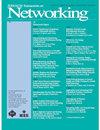协作式边缘计算中 DNN 推理网络效用的在线优化
IF 3.6
3区 计算机科学
Q2 COMPUTER SCIENCE, HARDWARE & ARCHITECTURE
引用次数: 0
摘要
协作边缘计算(CEC)是一种新兴模式,它将异构边缘设备协作为资源池,就近计算 DNN 推断任务,如边缘视频分析。然而,作为 CEC 中提高网络效用的关键环节,现有研究主要关注边缘设备之间的工作负载路由策略,目的是最大限度地降低路由成本,但从系统角度来看,工作负载分配和路由联合优化问题仍是一个未决问题。为此,本文提出了一种针对 CEC 的整体学习优化方法,即使任务输入率的效用函数先验未知,也能以在线方式实现网络总效用最大化。具体而言,我们在流量模型中描述了 CEC 系统的特征,并以跨层优化的形式提出了一个在线学习问题。我们提出了一种嵌套循环算法,利用梯度采样和在线镜像下降工具迭代解决工作量分配和分布式路由问题。为了提高嵌套循环算法的收敛率,我们进一步设计了单循环算法。严格的分析表明了该算法固有的凸性、高效的收敛性以及算法的最优性。最后,大量的数值模拟证明了我们解决方案的卓越性能。本文章由计算机程序翻译,如有差异,请以英文原文为准。
Online Optimization of DNN Inference Network Utility in Collaborative Edge Computing
Collaborative Edge Computing (CEC) is an emerging paradigm that collaborates heterogeneous edge devices as a resource pool to compute DNN inference tasks in proximity such as edge video analytics. Nevertheless, as the key knob to improve network utility in CEC, existing works mainly focus on the workload routing strategies among edge devices with the aim of minimizing the routing cost, remaining an open question for joint workload allocation and routing optimization problem from a system perspective. To this end, this paper presents a holistic, learned optimization for CEC towards maximizing the total network utility in an online manner, even though the utility functions of task input rates are unknown a priori. In particular, we characterize the CEC system in a flow model and formulate an online learning problem in a form of cross-layer optimization. We propose a nested-loop algorithm to solve workload allocation and distributed routing iteratively, using the tools of gradient sampling and online mirror descent. To improve the convergence rate over the nested-loop version, we further devise a single-loop algorithm. Rigorous analysis is provided to show its inherent convexity, efficient convergence, as well as algorithmic optimality. Finally, extensive numerical simulations demonstrate the superior performance of our solutions.
求助全文
通过发布文献求助,成功后即可免费获取论文全文。
去求助
来源期刊

IEEE/ACM Transactions on Networking
工程技术-电信学
CiteScore
8.20
自引率
5.40%
发文量
246
审稿时长
4-8 weeks
期刊介绍:
The IEEE/ACM Transactions on Networking’s high-level objective is to publish high-quality, original research results derived from theoretical or experimental exploration of the area of communication/computer networking, covering all sorts of information transport networks over all sorts of physical layer technologies, both wireline (all kinds of guided media: e.g., copper, optical) and wireless (e.g., radio-frequency, acoustic (e.g., underwater), infra-red), or hybrids of these. The journal welcomes applied contributions reporting on novel experiences and experiments with actual systems.
 求助内容:
求助内容: 应助结果提醒方式:
应助结果提醒方式:


